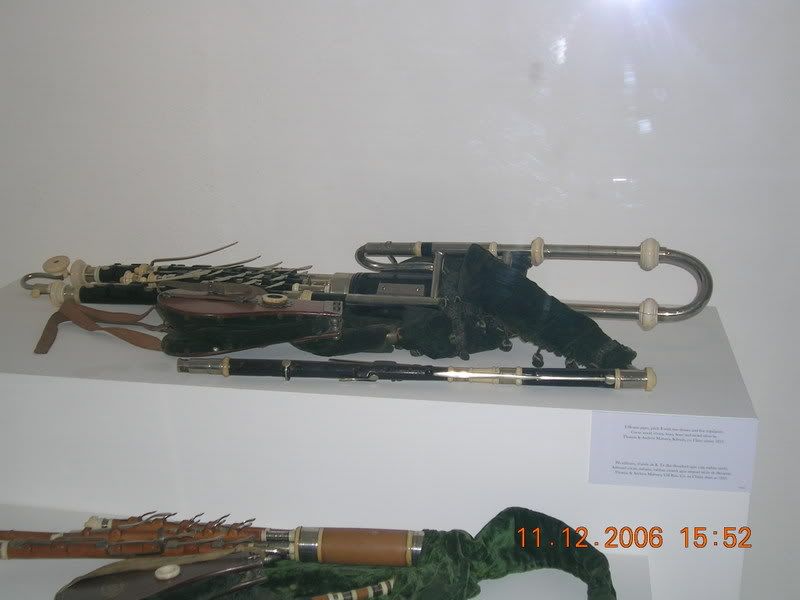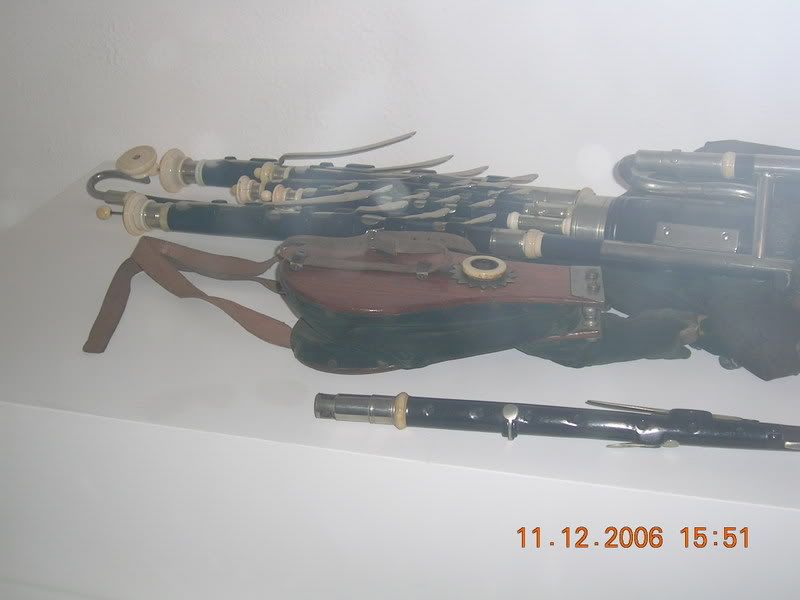I could be wrong ,but I think this is the set of pipes that ,that term was first applied to
It,s the Moloney brothers set that is pictured in IMAM page 339 .

RORY
I could be wrong ,but I think this is the set of pipes that ,that term was first applied to
It,s the Moloney brothers set that is pictured in IMAM page 339 .

RORY
From Kevin Rowsome’s website:
…there was danger of them passing into American ownership.
Well, then.
Pesky American’s buying up everything in the world like that ![]()
Pat.
… if we didn’t, somebody else would… like space aliens or something. ![]()
Interesting though, even back then we Yanks had a hunger for the Uilleann Pipes. ![]()
Prob’ly woulda turned that thing into a trombone and played music by - GASP! - John Phillip SOUSA! ![]()
![]()
The Photo of the Set from the museum suprises me, the Contra bass Regulator Low D Key is sitting bent really, really high! It would get in the way of the right wrist! Its hard to tell, but it seems like the Picture with Leo holding the set is far less extreme.
Here’s a link to another thread on the same subject. Peter Laban has some interesting information on the history of the set. Seems like it’s cursed - the potential owner gets injured, the makers go to the wall because of it - may be a museum is the best place for it ![]()
By the way, it looks very much like the Dave Williams/Alain Froment C# set featured in this YouTube clip. Is it possible that Dave Williams studied/copied the Vandeleur set?
Good to see such nice sets in a museum and not being played by a good piper… ![]()
PJ said: By the way, it looks very much like the Dave Williams/Alain Froment C# set featured in this YouTube clip. Is it possible that Dave Williams studied/copied the Vandeleur set?
Sorry the answer here is a definite no. That set is in concert pitch and the only similarity it has with the Moloney brothers set is the loop across the top - I don’t think it took much study to borrow that idea.
Ken
I have taken the Maloney paperclip set apart once in the museum during the mid 80 (in those days you could phone the curator and ask to see the pipes and if you spun a good story they’d let you spend the afternoon in the room where the stuff was, unsupervised hmm.) Anyhow, the thing is huge, you can drive a truck through the bass reg and drop a golfball into the holes of it. The Maloneys were blacksmiths and it reflects in their work, which is to say it wasn’t exactly refined.
I am not sure you know the picture of Thomas McCarthy the piper from Ballybunion (the man who lived in three centuries, born 1799 died 1904). Ballybunion being across the Shannon from the Maloney’s workshop he obviously had one of their sets, a four reg one, it has the keys bent up in the same way as the Vandeleur set. The picture (which was the first and rare postcard of a piper) is not in the NPU archive but I may scan it later. Another shot appears in O Neill’s IMM but doesn’t show the angle of the keys as well as the other one.
Aren’t the keys on that Moloney made out of forks, with coins for the “hole covers”? The low D key may be bent up so the player’s wrist goes under it, although it doesn’t seem like players in the old days used the DF/DG wrist chord much anyway - you never see it in photos or hear it on recordings. To get at it you’d have to use a shoulder strap which would probably dislocate your shoulder (speaking as one who knows!).
That Moloney chanter has the gravity-driven popping valve on it, too, for the curious.
Do you have more pics like that, Rory? Who made that other set? I think it was in An Piobarie actually. Bass reg plugs into the front of the stock. Built by Ryan, maybe.
It’ looks to me like the two bass regs have been switched. It would make more sense to have the high keys on the furthest regulator.
I’d like to see that photo of Thomas McCarthy that you mentioned Peter if you have time.
All the besht now,
Pat.
Don’t stand on your head when you go online, Pat.
The set’s pointing in the opposite direction other pics have shown it, maybe that’s confusing you (further).
I think someone switched the tenor and baritone regulators around for whatever reason, pipers used to do that - I wrote an article about it, you see it in a good few old photos.
You can think of this as a standard full set with an extra “baritone regulator” and the double bass.
It would make more sense to have the high keys on the furthest regulator.
Which direction is “furthest”? If you put keys like that on the bass reg you’d need to shift dimensions to play the small regs. It might come in handy for scratching your nose or pressing chanter keys, hrmm…
I’ve come to the conclusion that the Taylors had the right idea for a double bass - just put the keys next to the tenor regulator, set a bit lower, and you’re in business.
![]()
Before our lovely censor Joseph comes bellowing,
id like to say,
that the order of Regs looks to me, from back to Front,
Contra Bass,
Baritone, (who knows which is which?)
Baritone,
Tenor,
Bass.
I say that because the Back Bass Reg looks quite a bit larger than the front one, and the tenor is -possibly- next to the regular front bass. I can see a tuning bead.
I’ve been doing quite a bit of Regular Regulator metronome work, and its a shame there arent more Contrabass regulator players! It would be quite a sound. Especially in Bb or whatever rediculous keys this thing is in. Dicky Deegan springs to mind, but he only uses his full machine for certain bits, but I only have An Phib, not the second Album.
Of course, the stretch of Bb presents quite an obsticle to utilizing the regulators, the picture of Leo makes him look very small indeed, and any regulator work would have to be on a rediciculously contorted scale! Some tall lanky fellow might have better luck, but wasent Leo a smallish figure?
Another interesting bit is the Long, telescoping Ferrule at the end of the chanter, somewhat exaggerated, what?
Tenors and sopranos in Italian opera bellow, I (more or less) piss and moan.
Temper lads…
Who made that other set? I think it was in An Piobarie actually. Bass reg plugs into the front of the stock. Built by Ryan, maybe.
The other set is described in the SRS journal as:
1890-942
Coyne chanter, unknown body.
Coronet above Coyne Dublin.
Mathias Phelan on stock.
Chanter and original top ebony, body boxwood. Silver and ivory.
440mm
Fully keyed including D# and high E.
3.6mm
11.3mm
Three. Bass in stock.
47.25mm diameter
Original
Small stitched mahogany with boxwood inlay. Looks like M.Egan.
Two. Baritone and bass.Chanter has vertically operating popping valve.
Not at all like the work of Maurice or John. Could this be the work of John William?
\

RORY
I’m not convinced the regulators have been re-ordered - see the photo of Prof O’Leary in O’Neill page 339 - also I just noticed there’s an extra ivory mount at the bottom of the chanter which was present in 1906 or thereabouts but missing today.
Seeing this set in the flesh so to speak you are aware of the various angles that the regs come out of the stock to allow access to the keys, photos always exagerate or distort these angles. It looked fairly a sensible arrangement when I saw it - if anything with 5 regulators can be called sensible.
Ken